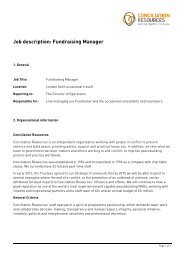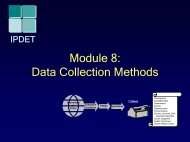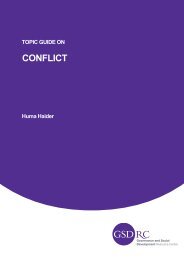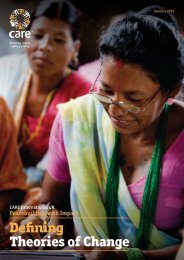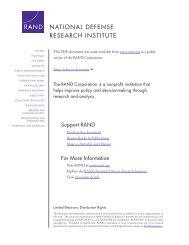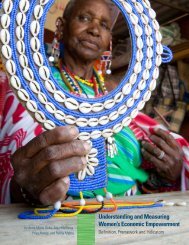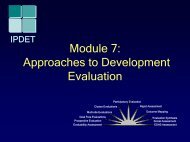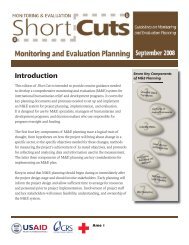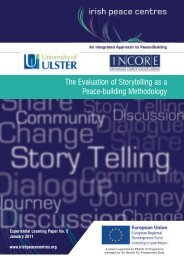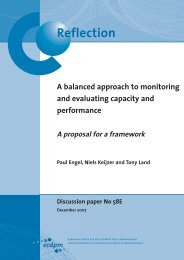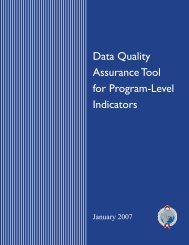Measuring Achievements of Private Sector Development in ... - DCED
Measuring Achievements of Private Sector Development in ... - DCED
Measuring Achievements of Private Sector Development in ... - DCED
Create successful ePaper yourself
Turn your PDF publications into a flip-book with our unique Google optimized e-Paper software.
<strong>Measur<strong>in</strong>g</strong> <strong>Achievements</strong> <strong>of</strong> <strong>Private</strong> <strong>Sector</strong> <strong>Development</strong> <strong>in</strong> Conflict-Affected Environments<br />
cha<strong>in</strong>s are <strong>in</strong>validated. 33 They should not be considered a prescriptive guide to programme activities,<br />
but a way to explore and challenge the assumptions <strong>of</strong> the programme.<br />
Consult all stakeholders. This is particularly important <strong>in</strong> a conflict situation, where you need<br />
acceptance from multiple groups. Stakeholder consultations can themselves have a positive impact<br />
upon the conflict by creat<strong>in</strong>g opportunities for shar<strong>in</strong>g and jo<strong>in</strong>t ownership. Consider whether<br />
groups <strong>in</strong> conflict should be consulted jo<strong>in</strong>tly or separately. However, be aware that groups may be<br />
biased towards particular positions, and consultations should be carefully planned so as not to<br />
favour any particular party. GTZ notes that “particularly <strong>in</strong> direct post-conflict situations,<br />
organisations and <strong>in</strong>stitutions with direct l<strong>in</strong>ks to conflict parties are <strong>of</strong>ten the most visible but not<br />
necessarily the most eligible partners.” 34 This is an extremely difficult issue for many projects <strong>in</strong><br />
CAEs, and it is essential to take the time to understand the different group dynamics and consult<br />
widely.<br />
Support project staff to understand the results cha<strong>in</strong>s and use it to drive their decisions. In a CAE<br />
various factors can m<strong>in</strong>imize staff understand<strong>in</strong>g <strong>of</strong> results cha<strong>in</strong>s, <strong>in</strong>clud<strong>in</strong>g high staff turnover,<br />
<strong>in</strong>creased use <strong>of</strong> partners, and low staff capacity. Consider mak<strong>in</strong>g it part <strong>of</strong> the <strong>in</strong>duction for new<br />
staff, and hold<strong>in</strong>g regular tra<strong>in</strong><strong>in</strong>g on it. For more strategies to address human resources issues, see<br />
section 8 on manag<strong>in</strong>g the results measurement system.<br />
1.3 Key resources<br />
1.3.1 Conflict Analysis Guidel<strong>in</strong>es<br />
Conflict Sensitivity Consortium. Conflict-Sensitive Approaches to <strong>Development</strong>, Humanitarian<br />
Assistance and Peace Build<strong>in</strong>g Resource Pack, Chapter Two. Very comprehensive conflict sensitivity<br />
guidel<strong>in</strong>es. Chapter two describes conflict analysis <strong>in</strong> detail and summarises 15 different conflict analysis<br />
tools from major donors. For each they discuss the primary purpose, summarise the ma<strong>in</strong> steps, and<br />
give examples <strong>of</strong> lessons learned and current applications. If you are select<strong>in</strong>g a conflict analysis<br />
framework, this is an <strong>in</strong>valuable resource.<br />
Collaborative for <strong>Development</strong> Action, Inc. The Do No Harm Handbook: The Framework for Analyz<strong>in</strong>g<br />
the Impact <strong>of</strong> Assistance on Conflict. This guide provides a step-by-step guide to assess<strong>in</strong>g the potential<br />
<strong>of</strong> a project to cause harm <strong>in</strong> its selected context.<br />
GIZ. Peace and Conflict Assessment (PCA): A Methodological Framework for the Conflict- and Peace-<br />
Oriented Alignment <strong>of</strong> <strong>Development</strong> Programmes. Exam<strong>in</strong>es the application <strong>of</strong> peace and conflict<br />
assessments at multiple stages <strong>in</strong> a project, <strong>in</strong>clud<strong>in</strong>g impact monitor<strong>in</strong>g.<br />
USAID. Conflict Assessment Framework. Version 2.0. Provides a framework for diagnos<strong>in</strong>g a conflict<br />
and generat<strong>in</strong>g responses. Application guidel<strong>in</strong>es can be found here.<br />
1.3.2 Results Cha<strong>in</strong>s and Theories <strong>of</strong> Change<br />
Becker, Sab<strong>in</strong>e. Conflict Prevention and Peace Build<strong>in</strong>g Elements <strong>of</strong> PSD/SED Programmes. Reviews<br />
many <strong>of</strong> the key relationships between PSD and peacebuild<strong>in</strong>g.<br />
33 Vogel, Isabel, Review <strong>of</strong> the use <strong>of</strong> ‘Theory Of Change’ In <strong>in</strong>ternational development’, 2012, 27.<br />
34 Becker, Sab<strong>in</strong>e, Conflict Prevention and Peace Build<strong>in</strong>g Elements <strong>of</strong> PSD/SED Programmes, 2006, GTZ<br />
Practical Guidel<strong>in</strong>es for Implement<strong>in</strong>g the <strong>DCED</strong> Standard. Version 2, July 2013<br />
19



